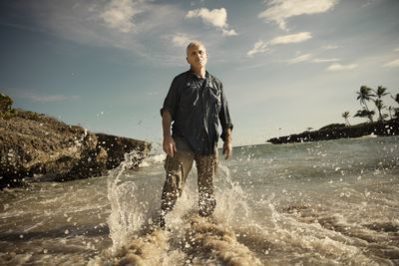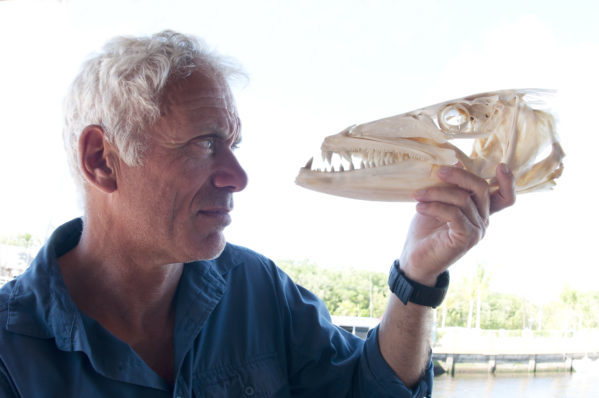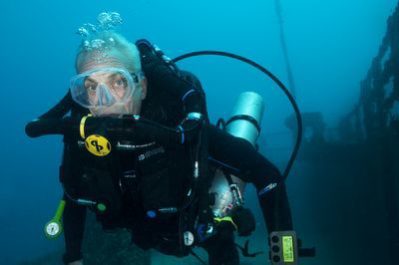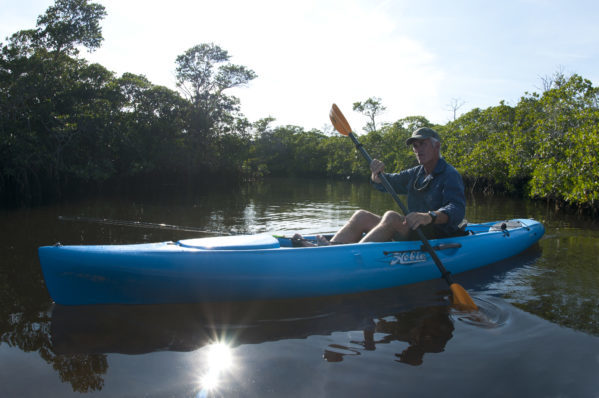INTERVIEW: Jeremy Wade heads to open ocean waters on reality series

Even though the show River Monsters promises freshwater adventures, host Jeremy Wade is heading into the unpredictability of the ocean on the new season of the hit Animal Planet series. The catfish and other monstrous fish that fans have come to know over the series’ many seasons will now be replaced by tiger sharks and other creatures of the deep big blue.
New episodes of River Monsters air Thursdays at 9 p.m.
“So it’s River Monsters, but we’re in the ocean, which might confuse a few people to start with,” Wade said recently during a phone interview. “But basically it’s still about the aquatic environment. Yeah, it was time for a new challenge.”
There are some advantages to fishing in the ocean over a freshwater environment. First off, in some parts of the ocean, clarity of the water changes the entire fishing technique. On the new season, Wade is getting into the water a lot more than he did in the murky rivers of the world.
“In rivers the only way … often that you can see what’s there is by putting a line in, but in the ocean, it’s possible to sort of jump in and see these things up close,” he said. “There’s a lot more of that.”

The structure of each episode is similar to previous River Monsters seasons. Wade and his crew track down some fisher stories, or myths, and begins to investigate them for some shreds of truth. By the episode’s end, he normally catches a so-called “monster.” The adventures on the new season often start on the shore and then head for deeper seas.
“I’m looking into whether there’s any real substance behind that, if there’s a grain of truth there,” he said. “So we start off, for example, looking at the myth of sea serpents, which people talk about all around the world. We started off looking at obvious creatures. What about eels? How big do eels grow? Do they really fit the bill? Not really. Sea snakes are not that big. They’re not that dangerous. They are venomous, but you’ve got to sort of get them really annoyed and really work hard to get bitten by one. And then we sort of stumbled across something else that might be behind that myth. And at that point, this is a deep-sea creature that is hardly ever seen, so actually working out what that might be is one thing. But how do we show that to anybody? We thought we were running into a bit of a dead end there, but then we had a bit of a tip off and actually ended up filming this creature.”

Wade called freshwater rich and diverse, but it simply can’t compete volume-wise with ocean water. Saltwater goes down deeper than rivers and lakes, and this makes for some interesting discoveries.
“I find some big waters quite intimidating, and this goes for big rivers, and it goes for big lakes as well,” he said. “As an angler, it seems to be a lot more random, and if it’s more random, then it’s a lot more time-consuming getting any kind of results. But actually what is true is once you sort of get deeper into it, you realize that there are similar principles. It is possible to read the sea. It is possible to narrow things down a bit and work out where the fish are. It isn’t just a case that they are randomly distributed.”
There was a risk that the River Monsters team might “fall flat” and not grab footage of a big catch by the end of each episode. However, Wade said, quite firmly, that they were able to achieve their results on the new season.
“I think we have a recognizable approach to underwater life, and we just thought, well, let’s see if this translates,” he said. “We had a bit of a wobbly start, literally wobbly. The boats on the ocean tend to move around a lot more than they do on freshwater, and so we had problems with cameramen getting very badly seasick, for example. About the worst thing you can do on a boat is look down at a camera eye piece. On a bumpy sea, you can sick in about 20 seconds doing that, so there were technical challenges like that.”
Angling on the open ocean also calls for scaling up of one’s gear; however, because Wade was used to bringing in monstrous catfish in freshwater, his gear was already marine-like. Also, these poles and rigs can often be difficult in a freshwater setting because of the hazards of sunken trees and other objects that snag the line. In the ocean, it’s much more open and object-free.

“As soon as you come close to the shore, you might have reefs, which are quite challenging — reefs, full of lots of sharp edges,” he said. “For instance, one of the programs we were in Australia, and I was trying to catch something very large very close to shore. And that involved hanging on and not letting that fish take too much line, but once you’re out in open water, you can let the fish run. And if you’ve got a boat, you can follow after it. The thing that you notice when you’ve got a sea fish on is that it’s all about speed, and that’s really a function of the nature of the environment. If there’s nowhere to hide, then the small fish have to go very fast in order to outrun the predators, and so the predators tend to be very fast as well. Sea fish tend to really take off from a standing start, and the speed, that can catch you unawares. And then your gear has to be up to it as well. Otherwise you’ll melt the drag on your reel.”
River Monsters serves multiple purposes. On one level it’s an entertaining reality series that follows Wade and his crew around the world. Viewers tune in for news of the latest catch. However, on the other hand, the show documents the difficult-to-accept realities that there are less fish in the world than years past. Wade sees these trends from a unique vantage point.

“Everywhere I go, I talk to the locals, and you hear about the changes that have happened just in living memory, just a matter of 50 years or so, tremendous decline,” he said. “In the context of rivers, the fish that I’m normally after are the apex predators, so they are the things that eat everything else. And from an angler’s point of view, I find those interesting to catch. They’re bigger. They look weird very often, but from the point of view of being a biologist, if the apex predators are there, you can be pretty certain that everything else is there as well. And the water is healthy. You don’t need to go and catch everything else. The fact that the apex predator is there that sort of tells you that everything else is there.”
However, he added, that if the apex predators — the so-called river and ocean monsters — are not there, that can spell doom. “If the apex predator is not there, then that suggests that there is a problem,” he said. “It could be overfishing, but in land it could be removal of water from the rivers. It could be dams. It could be pollution, and it’s exactly the same situation in the ocean. You would think with the ocean having so much more water that it will take a lot more abuse.”
That’s not the case.
One episode on the new season has Wade heading to the Sea of Cortez in Mexico. This trip proved this new reality all too well. “The shark numbers have gone right down,” he said of the Sea of Cortez. “Yes, everywhere you go, pretty much the resident fishermen will tell you how things are much worse than just a very short time ago.”
By John Soltes / Publisher / John@HollywoodSoapbox.com
River Monsters airs new episodes on Animal Planet on Thursdays at 9 p.m. Click here for more information. Click here for Hollywood Soapbox’s previous coverage of River Monsters.


Really like your show, I get to see fish I didn’t know exzisted, be safe and catch a river monster….. Glad to see your doing new shows on the Ocean.
I love your show an I feel that you’re doing a great insatiable shows and knowledge of creatures that are unknown, thank you. God bless and be careful.